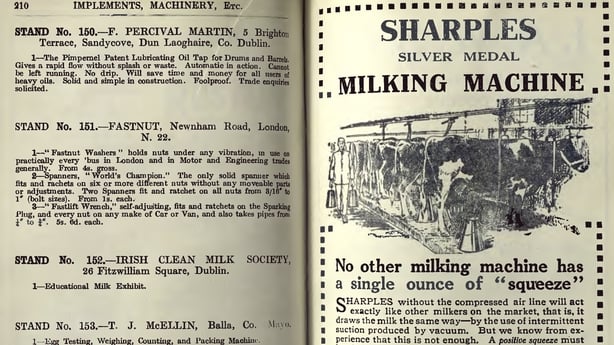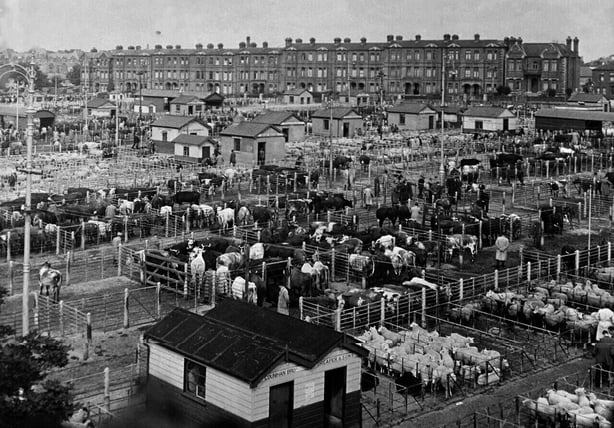Analysis: creating a clean, safe milk supply for the citizens of the capital city presented unique difficulties because of the product itself
From the mid-19th century onwards, sanitary reformers across Europe and America turned their attention to milk, recognising the important role that it played in a healthy diet, especially for the young. But creating a clean safe milk supply presented unique difficulties because of the uniqueness of the product itself. Milk sours quickly, especially at warmer temperatures and it can act as a vector for all sorts of disease many of which can be fatal for babies and young children.
At the turn of the 20th century, Dublin had the highest infant mortality rate in Britain and Ireland and much of this was blamed on dirty milk. During the first two decades of the 20th century, reformers like Sir Charles Cameron and Lady Aberdeen worked tirelessly to educate both milk producers and consumers about the need for cleanliness around milk.
Both were fully up to date with what were considered best practices in the modern world. Their initial focus was on dirt – that which could be seen - and efforts were made to engender a sense of disgust in the public to dirt. As the science of bacteriology developed, the focus shifted to the dangers presented by microbes which then became the subject of public health promotional material.
We need your consent to load this rte-player contentWe use rte-player to manage extra content that can set cookies on your device and collect data about your activity. Please review their details and accept them to load the content.Manage Preferences
From RTE Radio 1's Lockout, historian Donal Fallon on the role of Sir Charles Cameron in the 1913 Dublin Lockout
Ireland was not particularly slow in an international context when it came to improving practices around milk, but it was too slow for some. The Irish Clean Milk Society held its first meeting in May 1926 with health professionals such as Sir Edward Coey Bigger (who was elected president) and Dr Brian Crichton, the first paediatrician at Dublin’s Rotunda hospital, and many members of the National Women’s Health Organisation in attendance.
The society was a multi-denominational organisation and included many eminent members of Dublin and Irish society. Even renowned poet William Butler Yeats attended a meeting and left with 800 leaflets to distribute. As part of a larger international drive towards clean milk the society obtained its first promotional material from the English Clean Milk Society. Over the next decade, delegates attended international conferences on clean milk in London, Copenhagen and Berlin.
One of their first steps was to organise Clean Milk Demonstrations as part of the education exhibit run by the Department of Agriculture at the 1927 Spring Show in the RDS illustrating how clean milk might be made in a simple dairy without using complicated equipment. A ‘Clean Milking Competition’ was then organised in 1929 with the backing of the Dublin Cowkeepers and Dairymen’s Association who supported the competition program wholeheartedly and believed that certificates with marks earned and issued by the society would be valued by dairymen and employers alike who could use them to promote the effectiveness and quality of their dairies and dairymen.

Since maintaining a healthy herd was ultimately in their best interests, associations dedicated to cow testing (for bovine tuberculosis) were forming all over the country. In January 1930, Dublin hosted the Cow Testing Association Congress. Although Dublin media did not cover the event, harsh criticisms of the Dublin speakers were printed in a number of local publications. 'Officials paid by the State… mounted the rostrum at the Cow Testing Associations Congress, and not one of them had even the courtesy to disguise themselves as a farmer’ thundered The Kerryman.
Because they were clustered together in a relatively small area, Dublin’s dairy yards and milch cows were inspected much more frequently than rural producers which meant that the rate of bovine tuberculosis in Dublin city herds was far lower than in many areas of the country. This also meant that the likelihood was that those who contracted bovine tuberculosis in the city contracted it from contaminated milk brought into the city from outside.
A successful initiative followed in 1931. The Minister for Agriculture Patrick Hogan agreed to award certifications to owners of herds who had undergone tubercular testing and met strict requirements, coupled with the granting of a trademark for milk of the highest quality. The Association of Tuberculin Tested Herd Owners was established, with the goals of fostering collaboration and mutual aid as well as raising the consumption of milk.
From RTÉ Radio 1's Countrywide, Ella McSweeney visits the site of the old Dublin Cattle Market fondly remembered as "Cowtown" and talks to Declan O'Brien, author of The Dublin Cattle Markets Decline, 1955-1973
Bur while it appeared as if the Society was making great strides towards its goal of having legislation introduced to ensure a clean milk supply, there appeared to be little political appetite to enact the legislation and progress stalled. In January 1933, members contacted a number of organizations, including the Infant Aid Society, the Association Hospitals Board, the Tubercule Free Milk Producers Association, the Royal College of Physicians and the Veterinary Medical Association to send delegates to the Minister for Local Government and Public Health Seán T. O'Kelly to petition for the bill to be passed.
The Irish Clean Milk Society's primary goal was to protect children from disease and the Countess of Desart had stressed the importance of teaching children about hygiene and germs at school at the Society's first meeting in 1926. Dr Bigger commended the Infant Aid Society for insisting that the free milk they provided came from herds that had been tuberculin tested and, in 1934, he focused on the milk provided to the public schools.
A new programme had just been introduced providing Dublin schoolchildren with a ‘penny bottle of milk’, which was thought to be extremely beneficial to the health of young children. The society sent a circular to several schools to ascertain if they were actively sourcing their milk from tuberculin-tested herds. Out of the 30 schools that responded to the circular, only four were receiving milk from tuberculosis-tested herds where the dairy had a sterilizer and cooler.

Another circular sent to hospitals and nursing homes revealed equally depressing results. Only half of the 32 Dublin hospitals and nursing homes that the Society contacted in 1934 responded, and only 12 actively sourced their milk from herds that were tuberculin-free. If things were dire in the capital, the situation was even worse across the country: only two of the 43 hospitals contacted could guarantee that the milk they regularly provided to their patients was tuberculin-free
The Milk Supply Bill was finally introduced in July 1934 but it was deemed to fall short of its mandate. There was no requirement for milk to meet a certain standard or for all dairies to be licenced. Also, it did not grant urban authorities extra-terrestrial control, which prevented Dublin Corporation inspectors from visiting the locations of milk suppliers to the city who were located outside the city’s boundary.
The public had responded to public health messages regarding the possible dangers hidden in milk, and consumption was relatively low at this time, especially in Dublin. Despite this many institutions, even voluntary institutions like hospitals and schools, were reluctant to change, possibly because changing involved increased costs as certified milk was more expensive.
We need your consent to load this rte-player contentWe use rte-player to manage extra content that can set cookies on your device and collect data about your activity. Please review their details and accept them to load the content.Manage Preferences
From RTÉ Archives, Barry Linnane reports for RTÉ News in 1971 on the decline of the Dublin cattle market
This was a cause of concern to the medical community because milk was known to be an incredibly nutrient-rich food essential for healthy growth. Dublin City Council was also eager to restore public confidence in milk by launching the ‘Drink More Milk’ campaign, but some doctors still believed that pasteurisation was the only way to guarantee clean milk. They would have to wait until 1973 for this.
The Milk and Diaries Bill (1935) came into force in July 1937. It required that milk was instantly cooled, strained and prepared for transport; anyone involved in preparing milk for sale and consumption must be registered; dairies, dairy cows, and dairy staff all had to be kept impeccably clean. Additionally, the law applied to any establishment that regularly sold milk. However, it did not grant local authorities the right to send inspectors to examine cows and dairies outside their jurisdiction. The Irish Clean Milk Society disbanded in 1937 after realizing its objective with the enactment of the Milk Supply Bill.
Between 1937 and 1944, the numbers of cows housed in city yards had dropped from 5,006 to 4,050
The implementation of this bill had a profound effect on Dublin cowkeepers as it became noticibly more expensive to produce milk in the city. By the end of 1937, Dublin dairy employees were calling for a rise in pay, better working conditions, a ban on milkers performing other tasks and a restriction on hiring anyone under the age of 15.
Between 1937 and 1944, the numbers of cows housed in city yards had dropped from 5,006 to 4,050 despite the fact that Dublin’s municipal area increased significantly in 1942 as the city’s boundary extended to include Howth. This downward trajectory would continue and the gap between the amount of milk produced in city yards versus the amount of milk required rose steadily with the city becoming increasingly reliant on country milk.
The views expressed here are those of the author and do not represent or reflect the views of RTÉ





